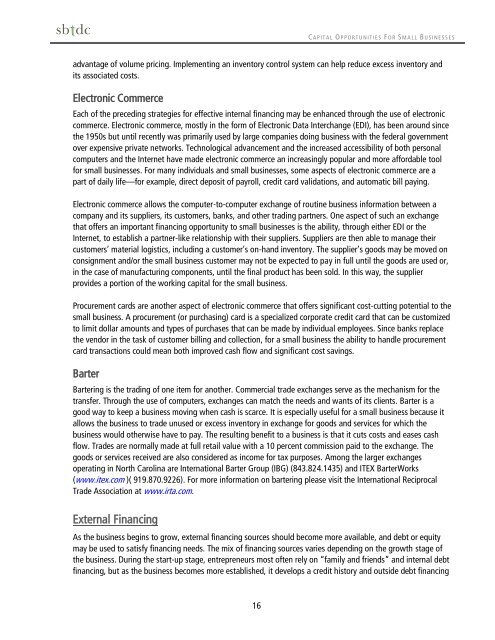Capital Opportunities for Small Businesses - sbtdc
Capital Opportunities for Small Businesses - sbtdc
Capital Opportunities for Small Businesses - sbtdc
Create successful ePaper yourself
Turn your PDF publications into a flip-book with our unique Google optimized e-Paper software.
C A P I T A L O P P O R T U N I T I E S F O R SMA L L B U S I N E S S E S<br />
advantage of volume pricing. Implementing an inventory control system can help reduce excess inventory and<br />
its associated costs.<br />
Electronic Commerce<br />
Each of the preceding strategies <strong>for</strong> effective internal financing may be enhanced through the use of electronic<br />
commerce. Electronic commerce, mostly in the <strong>for</strong>m of Electronic Data Interchange (EDI), has been around since<br />
the 1950s but until recently was primarily used by large companies doing business with the federal government<br />
over expensive private networks. Technological advancement and the increased accessibility of both personal<br />
computers and the Internet have made electronic commerce an increasingly popular and more af<strong>for</strong>dable tool<br />
<strong>for</strong> small businesses. For many individuals and small businesses, some aspects of electronic commerce are a<br />
part of daily life—<strong>for</strong> example, direct deposit of payroll, credit card validations, and automatic bill paying.<br />
Electronic commerce allows the computer-to-computer exchange of routine business in<strong>for</strong>mation between a<br />
company and its suppliers, its customers, banks, and other trading partners. One aspect of such an exchange<br />
that offers an important financing opportunity to small businesses is the ability, through either EDI or the<br />
Internet, to establish a partner-like relationship with their suppliers. Suppliers are then able to manage their<br />
customers’ material logistics, including a customer’s on-hand inventory. The supplier’s goods may be moved on<br />
consignment and/or the small business customer may not be expected to pay in full until the goods are used or,<br />
in the case of manufacturing components, until the final product has been sold. In this way, the supplier<br />
provides a portion of the working capital <strong>for</strong> the small business.<br />
Procurement cards are another aspect of electronic commerce that offers significant cost-cutting potential to the<br />
small business. A procurement (or purchasing) card is a specialized corporate credit card that can be customized<br />
to limit dollar amounts and types of purchases that can be made by individual employees. Since banks replace<br />
the vendor in the task of customer billing and collection, <strong>for</strong> a small business the ability to handle procurement<br />
card transactions could mean both improved cash flow and significant cost savings.<br />
Barter<br />
Bartering is the trading of one item <strong>for</strong> another. Commercial trade exchanges serve as the mechanism <strong>for</strong> the<br />
transfer. Through the use of computers, exchanges can match the needs and wants of its clients. Barter is a<br />
good way to keep a business moving when cash is scarce. It is especially useful <strong>for</strong> a small business because it<br />
allows the business to trade unused or excess inventory in exchange <strong>for</strong> goods and services <strong>for</strong> which the<br />
business would otherwise have to pay. The resulting benefit to a business is that it cuts costs and eases cash<br />
flow. Trades are normally made at full retail value with a 10 percent commission paid to the exchange. The<br />
goods or services received are also considered as income <strong>for</strong> tax purposes. Among the larger exchanges<br />
operating in North Carolina are International Barter Group (IBG) (843.824.1435) and ITEX BarterWorks<br />
(www.itex.com )( 919.870.9226). For more in<strong>for</strong>mation on bartering please visit the International Reciprocal<br />
Trade Association at www.irta.com.<br />
External Financing<br />
As the business begins to grow, external financing sources should become more available, and debt or equity<br />
may be used to satisfy financing needs. The mix of financing sources varies depending on the growth stage of<br />
the business. During the start-up stage, entrepreneurs most often rely on “family and friends” and internal debt<br />
financing, but as the business becomes more established, it develops a credit history and outside debt financing<br />
16









